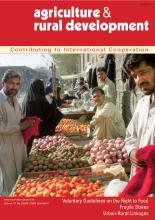Land Library Search
Through our robust search engine, you can search for any item of the over 73,000 highly curated resources in the Land Library.
If you would like to find an overview of what is possible, feel free to peruse the Search Guide.
/ library resources
Showing items 307 through 313 of 313.Afghanistan, Sierra Leone and Somalia: these three countries stand for different histories of a fragile state.The author of this article analyses different case studies to determine the various causes, such as the role of ethnic identities, claims to power by clans and other sub-state groups, or
Development policy has to deal with the full spectrum of fragility in developing countries, which can range from individual deficits, for example in guaranteeing security, to the total collapse of state structures.The scope available to development policy and other external actors is always limit
Urbanisation and economic transformation - the growth of non-farm, industrial and service sectors - offer many opportunities for improvements in poor people's lives.The crucial challenge is to ensure that places work better for people, providing an enabling and supporting environment for changing
Although «urban» and «rural» development are often considered as in opposition to each other and seen as competing with each other for investment and support, many urban centres owe much of their economic base to agriculture.
The relationship between urban and rural areas has undergone great change in recent years. It is now often difficult to clearly define the borders between the two; instead we find a continuum ranging from agricultural zones to suburbs, informal settlements and urban centers.
For the first time in the recent history of rural development there is a possibility of creating an infrastructure that dramatically reduces the isolation of rural life.
Agricultural value chains link urban consumption with rural production.

